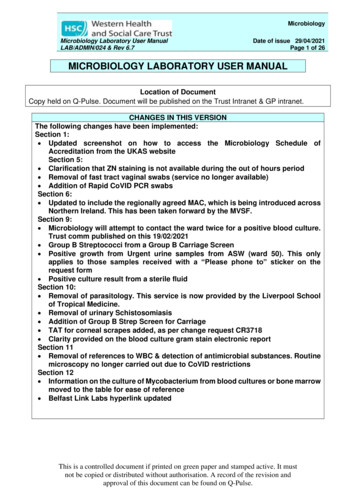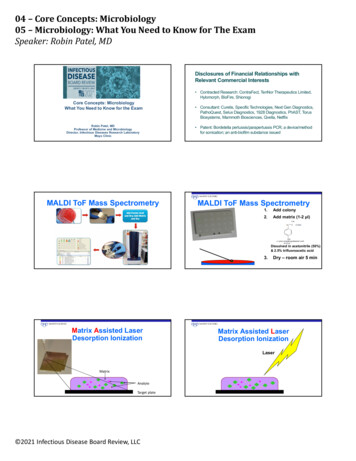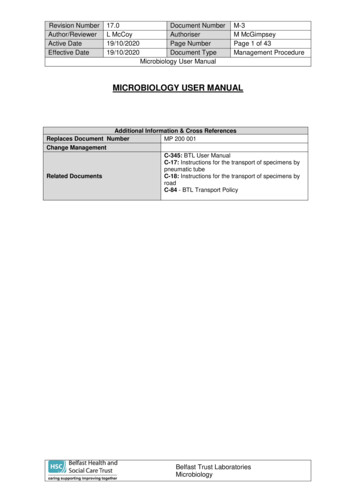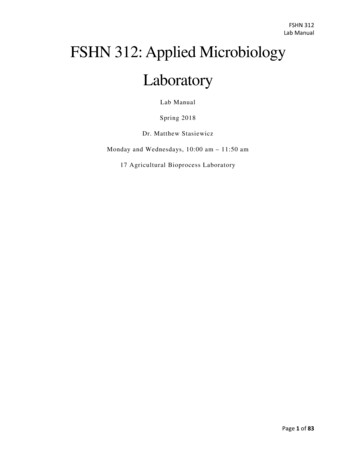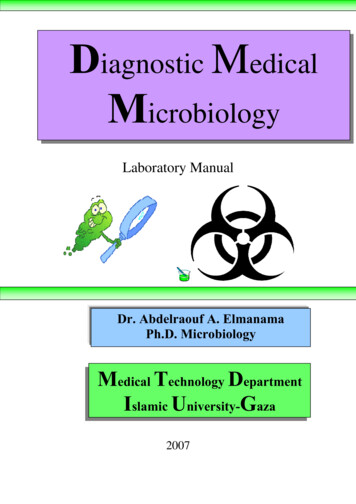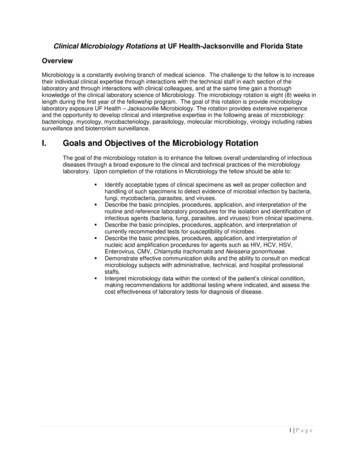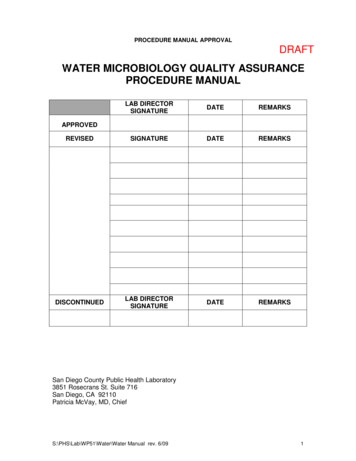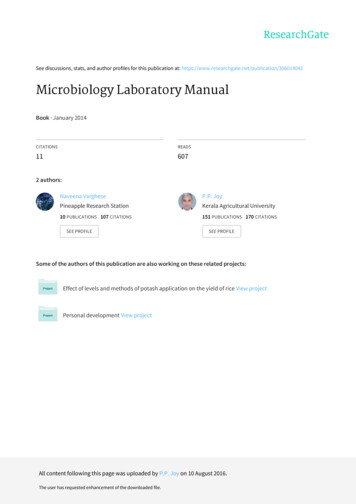
Transcription
See discussions, stats, and author profiles for this publication at: Microbiology Laboratory ManualBook · January 2014CITATIONSREADS116072 authors:Naveena VargheseP.P. JoyPineapple Research StationKerala Agricultural University10 PUBLICATIONS 107 CITATIONS151 PUBLICATIONS 170 CITATIONSSEE PROFILESEE PROFILESome of the authors of this publication are also working on these related projects:Effect of levels and methods of potash application on the yield of rice View projectPersonal development View projectAll content following this page was uploaded by P.P. Joy on 10 August 2016.The user has requested enhancement of the downloaded file.
Naveena VargheseJoy P. P.KERALA AGRICULTURAL UNIVERSITYPINEAPPLE RESEARCH STATIONVazhakulam, Muvattupuzha, Ernakulam District, Kerala, PIN-686 670Tel. & Fax: 0485-2260832, Mobile: 9446010905Email: prsvkm@kau.in, prsvkm@gmail.comWeb: www.kau.edu/prsvkm, http://prsvkm.tripod.com2014
Microbiology Laboratory Manual2CONTENTSSl.NoTitlePageNo.1Microbiology Laboratory: Basic Rules and Requirements32Methods in Microbiology3Cultural Characteristics of Microorganisms184Culture Medium205Media Preparation246Plating Techniques287Method of Isolation of Pure Culture308Culture Preservation Techniques319Bacterial Identification3310Biochemical Tests for Identification of Bacteria4111Fungi5712Identification of Fungal Contaminants in Plant Tissue Culture Lab6013Identification of Disease Causing Fungal Pathogen of Passion Fruit Nursery Plants6214Identification of Disease Causing Pathogens in Passion Fruit Plants from Field6415Identification of Pathogens Causing MD-2 Pineapple Fruit Rot6816Microbiological Examination of Milk6917Microbial Analysis of Food Items7018Bacteriological Examination of Water by Multiple Tube Fermentation Test7219Antibiotic Sensitivity Test (Kirby – Bauer Method) or Disc Diffusion Method75Units, Measurements, Conversions and Useful Data7613Naveena Varghese & Joy P. P. 2014. Pineapple Research Station (Kerala Agricultural University), Vazhakulam-686 670, Muvattupuzha, Ernakulam, Kerala.Tel: 0485-2260832, 9446010905; Email: prsvkm@kau.in, prsvkm@gmail.com; Web: www.kau.edu/prsvkm, http://prsvkm.tripod.com
Microbiology Laboratory Manual31MICROBIOLOGY LABORATORY: BASIC RULES AND REQUIREMENTSMicrobiology Lab Practices and Safety Rules Wash your hands with disinfectants when you arrive at the lab and again before you leave.Wear laboratory coats in the lab. Students with long hair must put up the hair.At the start and end of each laboratory session, students should clean their assigned bench-top areawith a disinfectant solution provided. That space should then be kept neat, clean, and unclutteredthroughout each laboratory period.Eating or drinking in the laboratory is not permitted. No mouth pipetting.Label everything clearly. Sterilize equipment and materials.Avoid loose fitting items of clothing. Wear appropriate shoes in the laboratory.Report any breakage of equipment to the instructor.Report any personal accidents such as cuts to the instructor at once.Turn off Bunsen burner when not in use.Discard all cultures and used glassware into the container labeled CONTAMINATED. (This containerwill later be sterilized.) Plastic or other disposable items should be discarded separately from glasswarein containers to be sterilized.Never place contaminated pipettes on the bench top.When you flame sterilize with alcohol, be sure that you do not have any papers under you.Before beginning your laboratory exercise, wash off the bench top with the disinfectant provided.When exercises are completed, wash off the bench top again. Always wash your hands with soap andwater before leaving the laboratory.Before leaving the laboratory, see that all the equipments are in the proper location and gas and waterturned off.Purchase a fine point, waterproof marker and small roll of masking tape. Use them to clearly label yourcultures.If you should spill or drop a culture or if any type of accident occurs, call the instructor immediately.Place a paper towel over any spill and pour disinfectant over the towel. Let the disinfectant stand for 15minutes and then clean the spill with fresh paper towels. Remember to discard the paper towels in theproper receptacle and wash your hands carefully.Disinfect work areas before and after use with 70% alcohol or fresh 10% bleach. Laboratory equipmentand work surfaces should be decontaminated with an appropriate disinfectant on a routine basis andespecially after spills, splashes or other contamination.Replace caps on reagents, solution bottles and bacterial cultures. Do not open petri dishes in the labunless absolutely necessary.Cultures are not to be removed from the laboratory unless the instructor gives permission.Always place culture tubes (broth and slants) in the upright position in a rack or basket for incubationor disposal.Dispose off all solid waste materials in a biohazard bag and autoclave it before discarding in theregular trash.Treat all cultures as potentially pathogenic, i.e., flood areas with disinfectant if cultures are spilled,wash hands after contact and notify your instructor at once.Read the instructions carefully before beginning an exercise. Also, make sure you have all thematerials needed for the exercise at hand before you commence the experiment. Ask the instructor forclarification of any points about which you are in doubt.Naveena Varghese & Joy P. P. 2014. Pineapple Research Station (Kerala Agricultural University), Vazhakulam-686 670, Muvattupuzha, Ernakulam, Kerala.Tel: 0485-2260832, 9446010905; Email: prsvkm@kau.in, prsvkm@gmail.com; Web: www.kau.edu/prsvkm, http://prsvkm.tripod.com
Microbiology Laboratory Manual 4Flame the inoculating loop or needle immediately before and after use. If viscous material is present onthe loop or needle, dry it at the side of the flame before placing it directly in the flame.Laboratory note books must be kept up-to-date. Illustrations should be done when requested.Make sure you consult the instructor to dispose of the cultures that are not needed any longer. Removeall labels and markings from the tubes before disposing of them; do not discard anything into the sinks.Please inform your instructor if you have any medical condition that could potentially affect yoursafety in the laboratory (eg: diabetes, epilepsy, immunosuppression etc.). This information will helpthe instructor to deal with any emergency that would arise. The information will be treatedconfidentially and it will not affect their ability to participate in the laboratory activities.Be systematic and logical. Keep a faithful record of all the experiments and observations. Update itregularly and submit it for evaluation at the end of each exercise.Work either using laminar air flow chamber or light the burner at least five minutes prior to makingany inoculations and work near the burner.Basic Record and Field Book/Lab BookThey are the permanent record of your work and hence should contain all the works related to the project.Basic Record is the whole systematic record of the work/study/project in full detail. Field book/lab book isfor your daily use in the lab/field and for rough works, calculations, plan schedules, memoirs, etc. You shouldrecord your work in these books systematically and regularly. All the experiments conducted in the lab mustbe recorded in these books. It is a compilation of whole work done by the researcher, so it must be wellmaintained. Also it can be a good reference book for those who come along. These are the property of theresearch station and hence you are not supposed to keep those books in your home. When you resign from thejob you should submit them up-to-date to the lab in charge without any delay.You should note the following points while dealing with field book.1.2.3.4.5.6.Keep the book neat and tidy.Utilize the book efficiently preserving the legibility of your writing.Name of the experiment should be entered along with the date of carrying out that experiment.Next you mention the requirements for the experiment.Summarize the theory and principle. This should be followed by the procedure.Mention the general calculations for the experiment. It should contain all the related works of the projectfor which it is meant to.The following points are to be taken care of:1. Do not tear pages from the field book. Number the pages of field book.2. Do not over write if a mistake has been committed in recording, put a line over it and write the correctword again.3. Complete the index, indicating the experiment, its serial number, page number on which it is written.4. The notebook should always be up to date and may be collected by the lab in charge at any time.5. You have to submit the field book and basic record at the end of every month on the date assigned.Mandatory Details Required the Basic Record1.2.3.4.Index: An index containing the title of each experiment with page number and Sl. No.Brief title of the experiment and date: Every experiment should have a descriptive title.Aim/Objective: A clear objective should be there.Technical Programme: This section should include any materials required, reagent composition, protocoland formulae. Procedure in the form of flow charts is helpful if it involves several parts.If anexperiment is a repeat of an earlier experiment, you do not have to write down each step, but can refer toNaveena Varghese & Joy P. P. 2014. Pineapple Research Station (Kerala Agricultural University), Vazhakulam-686 670, Muvattupuzha, Ernakulam, Kerala.Tel: 0485-2260832, 9446010905; Email: prsvkm@kau.in, prsvkm@gmail.com; Web: www.kau.edu/prsvkm, http://prsvkm.tripod.com
Microbiology Laboratory Manual5.6.7.8.5the earlier experiment by page or experiment number. If you make any changes, note the changes andreasons why.Observations: Periodical or quantitative or qualitative observationsResults: This section should include the final result of the experiment in accordance with the aim,organized in statistically valid tables and figures and discussed logically and justifiably. All raw data,including gel photographs, printouts, graphs, autoradiographs, etc if present are to be included.Inference: The results obtained should be interpreted in accordance with the principle of the experiment.Future Line: This section includes any suggestions from the protocol done, any refinements required etc.It is mandatory to have clear and accurate records of all experiments conducted in the laboratory.Basic requirements of a microbiology laboratoryA microbiology laboratory requires well-built rooms equipped with glassware, tools and equipments. Someof the most important items of equipment are the following.I) Common GlasswareThe most important glassware used in a microbiological laboratory are test tubes, culture tubes, Petri dishes,Measuring cylinder, pipettes, glass spreader, Flasks, screw-capped glass bottles, haemocytometer etc.1) Test Tubes, Culture Tubes and Screw-Capped Tubes These are made up of glass, one end of which is closed and other end is open. If the side wall of the open end is slightly curved outside, it is called test tube; if the side wall is smooth,it is called culture tube. When the side wall of the tube has screws so that a plastic cap may be fitted, itis called screw-capped tube. The test tubes are used for testing the chemicals such as pH etc., culture tubes are used for preparation ofagar slants and purification of microorganisms. The open end is plugged with non-absorbent cottonplug. Sometimes the microorganisms are purified and preserved in screw-capped tubes.2) Petri dish R. J. Petri, a student of the most renowned bacteriologist Robert Koch devised this dish, hence called“Petri dish”. It consists of two shallow glass dishes, the upper half or lid and the lower half. For the isolation and cultivation of different types of microorganisms these dishes are used in allmicrobiological laboratories. According to the requirement, its diameter varies. Molten agar medium is aseptically poured on the lower half of the sterilized Petri dish and then coveredwith the upper half. The petri dishes are sterilized by putting them in a Petri dish container and in turn in an oven orautoclave.3) Pipette It is a cylindrical and graduated glass apparatus. Its one end (lower side) tapers, while the other end (mouth piece) is normal. The middle portion is wideror of the same size as mouth end. It is graduated with numbers 1, 2 . . . n. . . . . . . 10. It has different measuring capacity such as 0.1, 0.5, 1, 5, 10 ml etc. Hence measures different quantities. It is used for transferring appropriate amount of liquid into other containers.Naveena Varghese & Joy P. P. 2014. Pineapple Research Station (Kerala Agricultural University), Vazhakulam-686 670, Muvattupuzha, Ernakulam, Kerala.Tel: 0485-2260832, 9446010905; Email: prsvkm@kau.in, prsvkm@gmail.com; Web: www.kau.edu/prsvkm, http://prsvkm.tripod.com
Microbiology Laboratory Manual6 It should be sterilized in an oven or autoclave before use by keeping in pipette container after beingplugged with cotton. For safety point, liquid should be sucked by attaching pipette-sucker at the normal end of the pipette. Pipettes should be sterilized by keeping them first in a steel can and is sterilized at 121 C for 30minutes.4) Glass Spreader It is made by bending a glass rod and making an L-shaped structure. It is used to spread evenly the microorganisms on agar surface present in liquid medium. The long arm is held in hand and the small arm is flame-sterilized and put on agar surface. It is brought forth and back so that microorganisms present in liquid may be dissociated and evenlyspread on the entire surface of agar.5) Haemocytometer This is a device used to measure the blood cells. This is also used for counting other cells viz., spores, bacteria etc. It consists of a number of chambers. Each big chamber has 1 X 1 X 0.1 mm 0.1mm3 volume with anarea of 1 X 1mm 1mm2. The depth of chamber is 0.1mm. (1 X 1 X 0.1 mm 0.1mm3 0.0001cm3 10-4cm3 10-4 ml) Hence, the bacterial cell count in the large chamber will be multiplied by 104 to givean estimate of bacterial cell number/ml. Each large chamber has 9 medium-sized chambers with 0.2 mm length, 0.2 mm width and 0.1mm depthwith a volume of 0.004 mm3. Each medium sized chamber is divided into 25 small chambers with 0.04 mm length, 0.04 mm widthand 0.1mm depth with a volume of 0.00016 mm3.6) Cleaning of Glass wares. Care should be taken that the glassware used in microbiology laboratory areneat and clean. After receiving and before start of work, the glassware must be chemically cleaned so thatthere should not be chemical deposits on its surface. Moreover, dirty form, then by soaking overnight inchromic acid. If the latter is not effective, a mixture of concentrated nitric acid and sulphuric acid can beapplied. All traces of the cleaner are then removed by repeated rinsing in tap water followed by distilledwater. Sometimes, new glassware may contain some bacterial/fungal spores that come with packingmaterials. The glassware from factory also contains some amount of alkali, hence to remove the alkali,2-3 % HCl is applied for 24 hours for neutralization.After the use of glassware the medium is removed and the former is treated with 3% commerciallyavailable Lysol solution followed by washing with boiling water. After drying, it can be kept in oven for3-6 hours at 140-180 C. The used pipettes, slides, cover slips, petri dishes, etc. are also cleaned by thismethod.Chromic acid is widely used as cleaning agent for glassware. It is a mixture of sodium dichromate andconcentrated sulfuric acid and possesses powerful oxidizing and solvent properties.Preparation of Chromic acid(i) First Method: Weigh 5g of sodium potassium dichromate and dissolve in 5ml distilled water in a beaker(250ml). Add 100ml concentrated H2SO4 slowly and stirring it constantly. The mixture is allowed to cool atabout 40 C and then stored in a dry glass stoppered bottle.Naveena Varghese & Joy P. P. 2014. Pineapple Research Station (Kerala Agricultural University), Vazhakulam-686 670, Muvattupuzha, Ernakulam, Kerala.Tel: 0485-2260832, 9446010905; Email: prsvkm@kau.in, prsvkm@gmail.com; Web: www.kau.edu/prsvkm, http://prsvkm.tripod.com
Microbiology Laboratory Manual7(ii) Second Method: Weigh 1g of K2Cr2O7 or Na2Cr2O7 and mix with 100ml of concentrated H2SO4. Afterstirring several times (preventing from cake formation) allow the mixture to cool at 40 C and store in aclean, dry stoppered bottle.II) Tools in Microbiology LaboratoryThe most common equipment are inoculation needle, inoculation/transfer loop, Bunsen burner, autoclave (orpressure cooker), incubator, hot air oven, refrigerator, centrifuge, spectrophotometer, magnetic stirrer,orbital shaker, hot plate, Distillation water still, UV- lamp, water-bath, carbon dioxide cylinder, single-panbalance with weights (for rough use), chemical balance, pH meter, colony counter, laminar air flow,electrophoretic apparatus, microscopes etc.1) Inoculation Needle & Inoculation Loop These are the most commonly used tools. Inoculation needle/loop is made up of a long platinum wire fixed into a metallic rod. A wire loop has a handle with steel screw shaft in which nichrome or platinum wire is to be fitted. The straight wire needle is used for transferring culture from solid medium. Even smaller amount ofliquid culture can be manipulated by using straight needle. The loop and wire are also used for picking small quantities of solid materials from a microbial colonyand can be used to inoculate either a liquid or a solid medium. Both the loop and straight wire must beflamed immediately after use to avoid contamination.2) Bunsen Burner Sterilization of tools by using spirit lamp is called incineration. Gas enters the burner at the base, and its supply is regulated externally by the gas cock. The amount of air can be controlled by rotating a sleeve that fits over the holes in the body of the burner. To keep the flame from blowing out special tips are frequently used to fit over the top end of the barrel. The proper method of lighting the burner is to close off the air supply, turn on the gas and light. Theflame will be large and yellow. Gradually open the air intake until the flame takes a blue colour.3) Water Bath Water bath is an instrument that is used to provide constant temperature to a sample. It consists of an insulating box made up of steel fitted with electrode heating coil. The temperature is controlled through a thermostat. In some of the water baths, plate form rotates, then it is called water bath shaker. It is more useful tomicrobiologists because it provides a uniform heat to the sample material meant for incubation. The main use of water bath is the incubation of samples at a desired and constant temperature.4)Laminar Air Flow Chamber Laminar air flow is an apparatus consists of an air blower in the rear side of the chamber which canproduce air flow with uniform velocity along parallel flow lines. There is a special filter system of highefficiency particulate air filter (HEPA) which can remove particles as small as 0.3 mm. In front of the blower, there lies a mechanism through which air blown from the blower produces airvelocity along parallel flow lines. The laminar air flow is based on flow of air current of uniform velocity along parallel flow lines whichhelp in transferring microbial cultures in aseptic conditions. Air is passed through the filters into theenclosure and the filters do not allow any kind of microbe to enter in to the system. Inside the chamber one fluorescent tube and another UV tube are fitted. Two switches for these tubesand a separate switch for regulation of the air flow are fitted outside the LAF. Due to uniform velocityNaveena Varghese & Joy P. P. 2014. Pineapple Research Station (Kerala Agricultural University), Vazhakulam-686 670, Muvattupuzha, Ernakulam, Kerala.Tel: 0485-2260832, 9446010905; Email: prsvkm@kau.in, prsvkm@gmail.com; Web: www.kau.edu/prsvkm, http://prsvkm.tripod.com
Microbiology Laboratory Manual 8and parallel flow of air current, pouring of media, plating, slant preparations, streaking etc. areperformed without any kind of contamination.Initially, dust particles are removed from the surface of the laminar air flow with the help of smoothcloth containing alcohol. Switch on the UV light for a period of 30 minutes so as to kill the germs, if anypresent in the area of working space.The front cover sheet of the apparatus is opened to keep the desired material inside. The air blower is setat the desired degree so that the air inside the chamber is expelled because the air inside the chambermay be contaminated / bring contaminants.Sit properly in front of the chamber and wipe the working table with alcohol to reduce the contaminants.All the work related to pouring, plating, streaking etc. are to be carried out in the flame zone of theburner or spirit lamp.In microbiology laboratory, horizontal type of laminar air flow is used to supply the air through filter.Precautions: Put off the shoes before entering to operate the apparatus. Wash the hands with detergents orsoap. One should not talk inside the chamber while performing microbial culture transfer, failing whichchances of contamination may be more which may come either through mouth, sneezing or air.5. Incubator An incubator is an instrument that consists of copper/steel chamber around which warm water or air iscirculated by electric current or by means of small gas flame. The temperature of the incubator is kept constant due to its control by using thermostat. The incubator is made up of double walled chamber adjusted to a desired temperature. It is done byusing an external knob controlling the thermostat system. The gap between two walls is insulated tocheck heat condition. A thermometer is inserted from the top for recording the temperature. Temperature greatly influences the microbial growth. Therefore, instrument is generally designed thatcan allow the desired microorganism to grow at a particular temperature. It is operated to allow the microbial growth on a suitable medium under proper temperature. In anincubator, the variation in temperature should not be more than one degree. Small square type incubators are better than large ones. If a lower temperature than the room is required,the water is circulated around the chamber to pass through an ice chest.Precautions: the door of the incubator should be opened only when necessary. If the tubes are to beincubated for a long time or at higher temperature, the medium may become too dry due to excessiveevaporation. In such cases cotton plug should be pushed inside the neck of the tube. The tube should becovered by a rubber cap so as to cover the plug. If the petriplates are to be incubated for a long time, theymay be placed in moist chamber with a damp sterile cotton wool at the bottom.6. Colony Counter It is a device used for counting small or closely growing colonies on the surface of media. For accuracy, the lens fitted or mounted in it helps to see the colonies. The lens is movable on the box and can be adjusted to see the colonies. The petriplate is kept on a slanting platform meant for it and illuminated with the help of light sourcefrom beneath. The numbers of colonies are read out with the support of digital reading meter.Naveena Varghese & Joy P. P. 2014. Pineapple Research Station (Kerala Agricultural University), Vazhakulam-686 670, Muvattupuzha, Ernakulam, Kerala.Tel: 0485-2260832, 9446010905; Email: prsvkm@kau.in, prsvkm@gmail.com; Web: www.kau.edu/prsvkm, http://prsvkm.tripod.com
Microbiology Laboratory Manual9Inoculation Loop & NeedleBunsen BurnerWater BathLaminar Air FlowColony CounterIncubatorFig. 1. Tools in microbiology laboratoryNaveena Varghese & Joy P. P. 2014. Pineapple Research Station (Kerala Agricultural University), Vazhakulam-686 670, Muvattupuzha, Ernakulam, Kerala.Tel: 0485-2260832, 9446010905; Email: prsvkm@kau.in, prsvkm@gmail.com; Web: www.kau.edu/prsvkm, http://prsvkm.tripod.com
Microbiology Laboratory Manual10The MicroscopeA good microscope is an essential tool for any microbiology laboratory. There are many kinds ofmicroscopes but the type most useful in diagnostic work is the compound microscope. By means of a seriesof lenses and a source of bright light, it magnifies and illuminates minute objects such as bacteria and othermicroorganisms that would otherwise be invisible to the eye. This type of microscope will be usedthroughout your laboratory course. As you gain experience using it, you will realize how precise it is andhow valuable for studying microorganisms present in clinical specimens and in cultures. Even though youmay not use a microscope in your profession, a firsthand knowledge of how to use it is important. Yourlaboratory experience with the microscope will give you a lasting impression of living forms that are toosmall to be seen unless they are highly magnified. As you learn about these “invisible” microorganisms, youshould be better able to understand their role in transmission of infection.Instructions Observe that a flat platform, or stage as it is called, extends betweenthe upper lens system and the lower set of devices for providing light.The stage has a hole in the center that permits light from below to passupward into the lenses above. The object to be viewed is positioned onthe stage over this opening so that it is brightly illuminated frombelow. Note the adjustment knobs at the side of the stage, which areused to move the slide in vertical and horizontal directions on thestage. This type of stage is referred to as a mechanical stage. A built-in illuminator at the base is the source of light. Light isdirected upward through the abbe condenser. The condenser containslenses that collect and concentrate the light, directing it upwardthrough any object on the stage. It also has a shutter or iris diaphragmwhich can be used to adjust the amount of light admitted. A lever isprovided on the condenser for operating the diaphragm. The condenser can be lowered or raised by an adjustment knob.Lowering the condenser decreases the amount of light that reaches theobject. This is usually a disadvantage in microbiological work. It isFig. 2. Microscopebest to keep the condenser fully raised and to adjust light intensitywith the iris diaphragm. Above the stage, attached to the arm, a tube holds the magnifying lenses through which the object isviewed. The lower end of the tube is fitted with a rotating nosepiece holding three or four objectivelenses. As the nosepiece is rotated any one of the objectives can be brought into position above thestage opening. The upper end of the tube holds the ocular lens, or eyepiece (a monocular scope hasone; a binocular scope permits viewing with both eyes through two oculars). Depending on the brand of microscope used, either the rotating nosepiece or the stage can be raised orlowered by coarse and fine adjustment knobs. These are located either above or below the stage. Onsome microscopes they are mounted as two separate knobs; on others they may be placed in tandemwith the smaller fine adjustment extending from the larger coarse wheel. Locate the coarse adjustmenton your microscope and rotate it gently, noting the upward or downward movement of the nosepiece orstage. The coarse adjustment is used to bring the objective down into position over any object on thestage, while looking at it from the side to avoid striking the object and thus damaging the expensiveobjective lens. The fine adjustment knob moves the tube to such a slight degree that movement cannotbe observed from the side. It is used when one is viewing the object through the lenses to make thesmall adjustments necessary for a sharp, clear image.Naveena Varghese & Joy P. P. 2014. Pineapple Research Station (Kerala Agricultural University), Vazhakulam-686 670, Muvattupuzha, Ernakulam, Kerala.Tel: 0485-2260832, 9446010905; Email: prsvkm@kau.in, prsvkm@gmail.com; Web: www.kau.edu/prsvkm, http://prsvkm.tripod.com
Microbiology Laboratory Manual11Care and Handling of the Microscope Always use both hands to carry the microscope, one holding the arm, other under the base. Before each use, examine the microscope carefully and report any unusual condition or damage. Keep the oculars, objectives, and condenser lens clean. Use dry lens paper only. At the end of each laboratory period in which the microscope is used, remove the slide from the stage,wipe away the oil on the oil-immersion objective, and place the low-power objective in vertical position. Replace the dust cover, if available, and return the microscope to its box.Handling and Examining CulturesMicroscopic examination of microorganisms provides important information about their morphology butdoes not tell us much about their biological characteristics. To obtain such information, we need to observemicroorganisms in culture. If we are to cultivate them successfully in the laboratory, we must provide themwith suitable nutrients, such as protein components, carbohydrates, minerals, vitamins, and moisture in theright composition. This mixture is called a culture medium. It may be prepared in liquid form, as a broth, orsolidified with agar, a nonnutritive solidifying agent extracted from seaweed. Agar media may be used intubes as a solid column or as slants, which have a greater surface area. They are also commonly used inpetri dishes, or plates.Solid media are essential for isolating and separating bacteria growing together in a specimen collectedfrom a patient, for example, urine or sputum. When a mixture of bacteria is streaked across the surface of anagar plate, it is diluted out so that single bacterial cells are deposited at c
Microbiology Laboratory Manual Book · January 2014 CITATIONS 11 READS 607 2 authors: . Microbiology Lab Practices and Safety Rules Wash your hands with disinfectants when you arrive at the lab and again before you leave. Wear laboratory coats in the la

